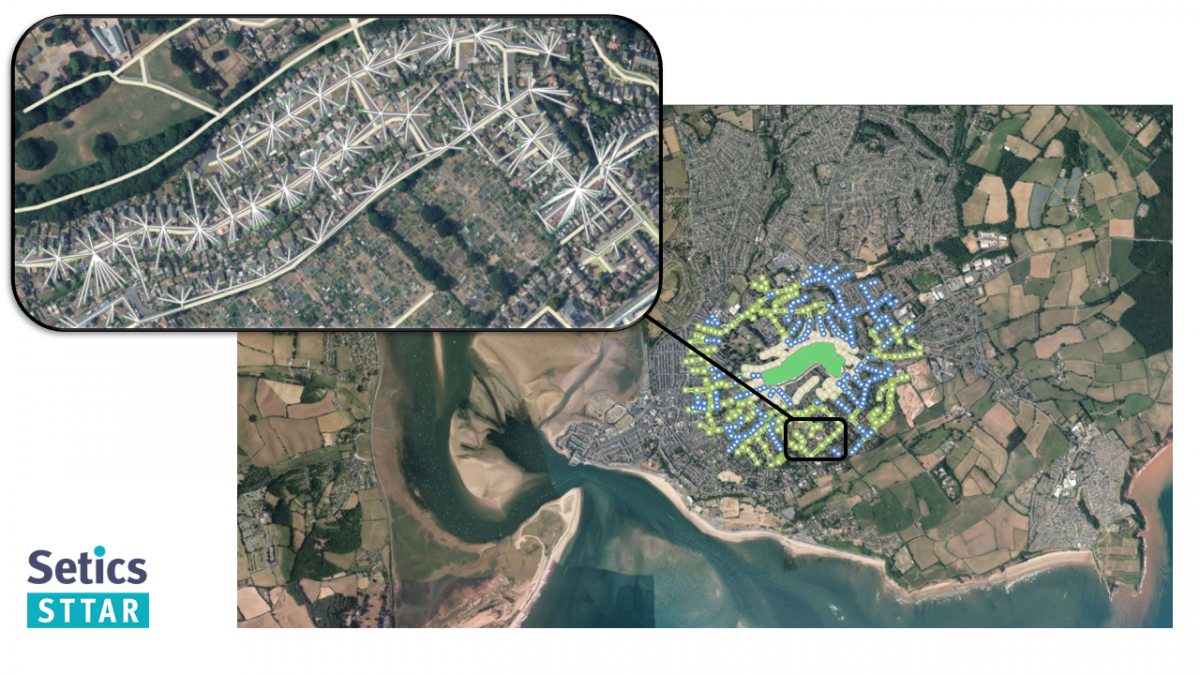Broadband networks are undeniably at peak demand, with the current global crisis providing the industry with its own ‘new normal’, with consumer’s altered perception of ‘normal’ bandwidth levels.
At the same time, ‘consumers have been unwilling to pay for this added capacity’. That’s the view of Kurt Raaflaub, Adtran’s head of strategic solutions marketing. ‘Network operators must squeeze every bit, or byte, of value out of their networks to meet demand.’
SDN-based networks are being deployed to enable the future self-driving network. These modern architectures, said Raaflaub, could offer the necessary hooks to support applications and processes that effectively analyse, automate and optimise the network.
‘This is critical,’ he said, ‘if network operators wish to fully maximise their network assets to hold multi-billion-dollar capex budget levels in check. But how will this next level of network efficiency come to bear, as service providers respond to the next wave of high bandwidth use cases that consumers will demand?’
The average peak usage per subscriber grows annually from 25 to 50 per cent. The lower bound equates to 10 times more bandwidth to serve the subscriber base in the next decade. The upper bound equates to 57 times. Failing to successfully meet this demand could mean losing subscribers and their associated revenue that fund expansion, therefore creating a vicious cycle that leads to service provider irrelevance.
‘Next-generation networking components that adhere to Moore’s Law,’ said Raaflaub, ‘will continue to aid network architects by providing the next-level processing power and memory required to propel the network forward, at a lower cost-per-bit. Network operators will employ next-generation 10Gb/s fibre access technologies and N x 100GE aggregation platforms with traffic carrying capabilities to rival the performance of yesteryear’s intercontinental transport networks. The reality is these brawny new fibre access solutions will only partially solve operators’ capex crutch. We need more brains!’
Always open
To enable network automation, Raaflaub believes modern access networks must use open networking architectures that support the ultra-short micro-release schedules needed to build the self-driving network. ‘Traditional telco and cable operators are adopting new open service architectures and becoming more agile as they deploy new applications to their networks,’ he said. ‘Common open APIs defined by industry consortiums – not individual networking equipment suppliers – will be natively supported by all network elements and management systems for a standardised, efficient way of extracting real-time data from the network, while simultaneously delivering capacity and performance optimising instructions.’
These new open, programmable and scalable broadband and enterprise connectivity networks, known as software-defined access (SD-Access) networks, are built using modern architectural principles that apply lessons learned from data centre networks. This represents a shift from previous networks that have relied on closed, monolithic systems managed by vendor-specific management systems. This evolution could enable operators to vastly lower their cost to build, operate, maintain and innovate their network.
Raaflaub said: ‘Rolling out a new application can be a complicated and costly endeavor. SD-Access networks support many key enablers that will afford network operators the ability to maximise the use of their network capacity, and do so without burdening the network with the large processing overhead common with traditional [SNMP] simple network management protocol-based collection and organisation of network information.
‘This brings up another critical reason why the support of open protocols like Restconf and Yang are natively supported by both network controllers and underlying network elements, as they eliminate the processing time and power required to translate to and from legacy messaging like SNMP.’

Missed opportunity
Raaflaub explained real-time collection and storage of network data is ‘pushed’, not ‘pulled’ every five minutes as in traditional polling. However, he warned, critical network and/ or subscriber insights that offer actionable intelligence to operations personnel could be missed. ‘To enable network optimisation,’ he said, ‘the status of ports, links, memory and CPU need to be accessible in real-time to offer the most effective analysis and insight.
‘The reality is that a dynamically provisioned application could be spun up, remediate an incident and taken down before the typical fiveminute SNMP polling cycle.’
In terms of applications, streaming telemetry often affords the operator deep and continuous visibility, providing end-to-end insights into the performance of programmable network elements and applications that run across them. The operative word, said Raaflaub is ‘streaming’. He feels traditional methods of collecting network telemetry like SNMP, syslog messages and CLI show commands can’t keep up.
‘The lack of granular, real-time analytics-ready network data severely limits the usefulness of network automation, traffic optimisation, reactive self-healing or proactive preventative intervention applications,’ he said.
This streaming telemetry data needs to be stored, accessed and processed efficiently. He argues that Elastic cloud storage will allow cloud service capacity and performance to expand or contract as needed, for better efficiency.
‘Services should always be controlled through a single API or centralised hub to improve reporting, maintenance, consistency and optimisation. Using a piecemeal methodology to create automation services will not scale at the same pace the network will be required to grow. Processing real-time network data is best done in a closed feedback loop. Closed-loop automation identifies and assesses network incidents and conditions, weighing them against traffic demands, resource availability and SLAs.
‘These intent-driven SDN networks,’ he added, ‘then utilise their informed view of the network topology to dynamically evoke realtime commands to remediate a fault, congestion or alert in the most effective way.’
Bolt from the blue
Attempting to architect similar outcomes with more rigid custom scripting approaches, warned Raaflaub, can result in unpredictable outcomes. ‘Automation frees operators’ personnel to work on other things,’ he said. ‘Long after architects that created the home-grown automation applications have moved on, the business is left maintaining, securing and advancing these systems, often at an expense that far exceeds anticipated savings.’
For Saoirse Hinksmon, marketing manager at software provider Benu Networks, a cloudnative edge coupled with automation is what could help operators fully reap benefits such as flexible network deployment and operation, by distributed or centralised deployment and independent scaling between control plane and user plane functions.
This way, she said, can help secure the network by delivering wide-area networking and security as a cloud service directly to the source of connection, rather than the enterprise data centre. Service delivery could also be accelerated, enabling DevOps, CI/CD, microservices and containerisation. In addition, it could ensure that vulnerable software is repaired as soon as updates are available.
Tip the scale
Another benefit of this application, said Hinksmon, is its ability to scale elastically, so operators can scale down when the workload is small and up without any reprovisioning during peak time. It can therefore help address costs.
She said: ‘Cloud-native edge can harness the power of distributed systems so that instead of having an enormous backhaul of data that needs to be processed at central servers, a large part of the processing work is completed at the edge of the network. For service providers who want to cost-effectively deploy new services at the edge and power-constrained network edge, leveraging the power of cloud-native edge or cloud-native broadband network gateway has to be a priority.’
Looking at automation from an end-user’s stance, Todd Kiehn, VP product management at ISP and global operator GTT, offered his thoughts on what network management could look like as we come out of lockdowns, noting that ‘remote working will likely be here to stay’.
Flexible working
Kiehn cited figures from International Data Corporation which estimate that postpandemic, more than half of employees will either work remotely full-time, or have a hybrid arrangement between home and office. ‘Given this trend,’ said Kiehn, ‘businesses are shifting their attention to improve the remote working experience, making sure employees have secure access to the resources and tools they need to work efficiently and productively. As a result, how IT teams manage the network and security in a distributed enterprise context is becoming more important.’
He explained that currently, businesses typically buy network bandwidth for a location in fixed increments. In time he believes this approach will change to focus on the users and usage, rather than the location, so businesses are not committed to bandwidth for offices, when a significant portion of users may be working at home. ‘This will make for much more flexible and cost-effective network consumption, which will appear seamless to the business,’ said Kiehn.
Traffic prioritisation will also be more userfocused, he continued, as well as applicationdriven. The prioritisation and business policy applications of an SD-WAN will slowly transition to run on the user’s laptop or mobile device, as well as the overall corporate network.
‘This will deliver better performance for remote users,’ he said, ‘and allow them to participate in corporate priorities and policies. This means IT has a better understanding of business needs and can adapt network provisioning accordingly, even when the user is nowhere near a corporate office.’
Looking forward Kiehn believes that IT teams will start turning to new technology, such as AI systems, to automate network management and SD-WAN. ‘In the coming year, we’re going to see a lot more of this, not just on the application side but also on the network and for security,’ he said. ‘Increasingly AI systems will understand what needs to be done and automatically tune the network and security measures to meet user requirements. This means businesses will no longer have to devote internal resources to these tasks. The network will be able to heal, adjust and adapt without human intervention.’
In advance
While we’re not quite there yet, Kiehn opines that the tools are being built to achieve this with AI operations for IT (AIOps). ‘Advancements should be made this year,’ he said, ‘allowing the industry to achieve significant network automation in the next three to five years. In time, we should be able to do things like automated application performance adjustments and threat network traffic analysis – for example, identifying changes in traffic patterns for anomalies, and spotting changes in traffic that would suggest a network has been compromised.’
Kiehn addressed the issue of trust when it comes to automation and AI for businesses. He feels that, as more and more enterprises get used to the idea of network automation, they will trust AI to control more operations. ‘As a transitional step towards full automation,’ he predicted, ‘we could see industries adopt a classification system for different levels of human intervention – similar to what SAE International has devised for self-driving cars. We’ll soon be moving from a scenario where an AI spots an issue and asks if it can fix it, to one where you get a report at the end of the day to explain what went wrong and what happened to resolve it. With this type of advanced intelligence and proactive resolution, you won’t be aware of the problem until after AI has fixed it.’
Secure Access of Service Edge (SASE) is another concept Kiehn feels is likely to grow. SASE involves taking corporate networking concepts like SD-WAN and tying them to security capabilities, expanding beyond nextgeneration firewalls to include cloud-based security tools such as secure web gateway, zero trust network access and cloud-access security broker. This approach, he said, will help integrate all aspects of networking and security to minimise security gaps and maximise performance.
‘Together,’ said Kiehn, ‘these changes in network and security management will enable businesses to take a more integrated approach to the network stack. Rather than looking at several different technologies to separately manage the network and security, businesses will turn to solutions that can best cover it all for improved efficiency. We will see businesses opting for fewer solutions that have more comprehensive capability, rather than a myriad of solutions tailored to every system.’
SPONSORED CASE STUDY: UK OPERATORS SEE GROWTH PLANS COME ALIVE THANKS TO AUTOMATED PLANNING AND DESIGN

Alternative network providers (altnets) have fast become renowned across Europe for their contribution to the accelerated fibre rollout.
Take Jurassic Fibre, for example. Founded in 2018, it has ambitious plans to invest £250m over the next five years, starting in the southwest of England. The company decided at an early stage that automation would be a key component in growing its network and its business at scale.
Terri-Ann Grant, director of network design & GIS operations explained: ‘While we launched in late 2018 for general deployment, planning would have started long before. During the planning stage we decided it was critical to make sure we had a tool that was able to automate, to a certain level, the designs for a rollout. This was also tied to the fact that we had a plan to move very quickly.’
The company carried out due diligence, evaluating a number of solutions to meet its bespoke strategic needs. ‘We went through several of them,’ said Grant, ‘to observe their functionality, what the rollout plan is for development in the future, and to make sure they are fit for purpose, in terms of how we need things to be configured.’
Towards the end of the evaluation, Jurassic Fibre found one solution – pre-planning, design and optimisation software for fibre deployment, Setics Sttar – to be the most compatible with its needs.
It was created by Setics, an independent consulting firm for digital infrastructures and telecoms. ‘Setics Sttar was among the most impressive,’ said Grant, ‘based on what already exists in terms of the overall functionality, when compared to the other tools that were available.’
Customer care
What conclusively made up the ISP’s mind was the customer care available. ‘The Setics team was very responsive,’ she explained. ‘That was key for us, because being a new ISP, a lot of the tech responses are based on reputation and credibility, which we had not established at that point. But they were responsive and quick to take us through a demonstration of how we could possibly apply it to our business, as well as what they would have planned for rollout in the next six months to a year.’
The Setics Sttar software was delivered with a complete automation process, the Automation Workbench, which aims to add data flows before and after Setics Sttar, to complement the design automation with preand post-treatments to process data, produce specific outputs and integrate to the local IT systems.
‘We wanted to make sure we could automate as much of the process as possible,’ revealed Grant. ‘What we found is that this allowed us to do so quickly, it was easy to use, easy to train our staff and we had the support structure that would allow us to move quickly.’
This is no exaggeration! Jurassic Fibre started out with a relatively small footprint covering, from Sowton to Exmouth in Devon, and quickly expanded to include areas such as Honiton and Barnstaple in the county; with Bridgwater, Wellington, Taunton and Yeovil, all in Somerset, currently being built. The company also recently announced it is extending its network to Sherborne, in Dorset.
‘We are moving very quickly,’ said Grant, ‘and having the Setics design tool on board has allowed us to produce these designs at speed. What would have taken us probably a week or two to put together, we can now turn around in two to three days, depending on the complexity of the design.
‘That was one of the things that attracted us to the tool and has kept it on our books, as it will be key for us moving forward.’
A winning team
Fibrus Networks, a Northern Ireland-based independent provider, was also founded and launched in the latter part of 2018, and is already becoming recognised as one of the region’s fastest-growing full fibre network providers.
At the start of last year, Fibrus started the process to win a tender for Project Stratum – a Department for the Economy initiative to improve broadband connectivity by extending next-generation access broadband infrastructure to around 79,000 premises across Northern Ireland yet to access NGA broadband services.
The company selected Setics to assist with the tender, after hearing about its success in the Republic of Ireland. Setics's client won the bid for works across more than 500,000 properties in the region, under the government’s National Broadband Plan. Thomas Grant, chief technical officer at Fibrus revealed: ‘I was familiar with the National Broadband Plan and Setics’ role on that, so I got in contact and brought the team in to work with the architecture of what we wanted them to produce first.’
Accurate price prediction
Setics, using Setics Sttar automation software, worked closely with Fibrus, acting as a serviceproviding extension of the firm’s team to develop a winning bid.
Following a trial in Cookstown, County Tyrone, the partnership was sealed. In a few days, Setics managed to produce a network of 78,750 premises, creating the necessary elements to answer the tender. Continued Grant: ‘Based on our architectural requirements, Setics ran a high-level automated design that produced a bill of materials. With that bill of materials, we were able to accurately price the build of the network throughout Northern Ireland, and ultimately win the bid.’
The next step for Fibrus is the build itself. ‘Coalisland was our first OLT, which goes live in April,’ said Grant, ‘and the next five have been designed.
‘We’ve compared those to the Setics model and the variations, and there’s very little variation, less than 10 per cent, which proves the accuracy of the design. I would say Setics has been invaluable to what we’ve achieved so far.’
The partnership has continued on the provider’s commercial rollout. Grant elaborated: ‘For our commercial build, we have been financed to build up to 140,000 homes passed in the next three years throughout Northern Ireland. We have a plan in place for that, which we’re working on with Setics at the moment.’
At the time of going to press, Setics has produced an accurate design for 160,000 premises for these works, in just two weeks. It is little surprise, then, that Grant revealed there is another project in the pipeline, about which he is also speaking with Setics, so watch this space!


